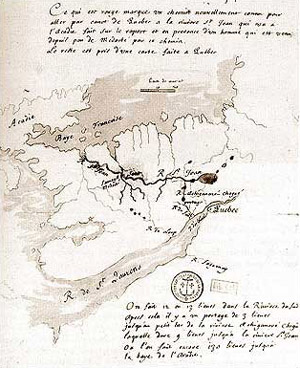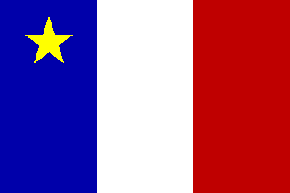|
|
Aroostook: The Early Years |
|
|
Aroostook: Origins of the NameAroostook was named for its most prominent river, and is derived from a native Wabanaki word, sometimes spelled Restook, Ristook, Aroostic, and finally, Aroostook. Different people have assigned different meanings to the name in the original language. Moses Greenleaf supposed that it is the same name as Wal-loos-took, the Wabanaki name for the St. John, which he understood to mean good river or fine river. On the original tracing of the map that he drew of Maine, drawn about 1814, it was spelled in the way that it is now spelled -- Aroostook. Sockabasin, a Penobscot Indian, told William Willis in 1840 that the name meant smooth river. In his Woods and Lakes of Maine, L. L. Hubbard writes: "Aroostook, Alloostook, Oolastook, 'beautiful river'," and refers to Rand's Micmac Reader. Wallastook, or Woolastook, he says, means "stream where you get smooth boughs." He concludes that authorities generally think that the word means fine, good or beautiful river. The chief surveyor for the United States when the boundary line was run due north from the monument at the source of the St. Croix in 1817, John Johnson, reports that two aged Indian chiefs told him that the true name was Listook." In his New Familiar Wabanakis and English Dialogues, Joseph Laurent, an Wabanaki chief, writes, "Aroostook (Wabanakis) from Walastegw, shallow river, or perhaps Wlastegw, good river." William F. Ganong, known as the foremost authority on Indian place names in New Brunswick, writes that the exact origin of the name is uncertain, but that it probably derives from the Maliseet name for the St. John, Wool-ahs-took, although it may be a distinct and related word. In Maliseet the name is Loostook, or Loos-ta-gook. "But the Maliseets neither know the meaning of the word, nor do they identify it with Wool-ahs-took. Perhaps the name is not aboriginal, but only their way of pronouncing the form Aroostook." The first occurrence of the name seems to be that of De Rozier's map of 1699, where it is spelled Arastuk, and applied to an Indian settlement on the St. John above the mouth of the Aroostook. Map makers have also called the river Arestook, Restook, Little Restigouche, Riviere Jaques, Jaquet, R. Chun, and Machias. By the end of the Revolutionary War, most of the area was yet unmapped and unexplored. The Aroostook, or its name, was unknown. Maps of the region either ignored the river entirely or left it unnamed. A 1794 map calls it R. Jaques. Northern Maine was then included in Lincoln County. When the counties of Hancock and Washington were separated from Lincoln County in 1789, the townships along the present eastern boundary were included in Washington County, while the townships to the west were assigned to Hancock County. The name Madawaska comes from two Micmac words: Madawes, meaning porcupine, and kak (or kek), meaning place; the place or land of the porcupine. Laurent, an Wabanaki chief, suggests a different derivation, saying that the name in Wabanaki was Mado bashika, signifying the mouth of a river, where there is grass or hay. The French softened the name to Madoueska, then the English hardened it again to Madawaska. Even before the first permanent settlement of the area took place, the St. John and the Madawaska were part of the inland waterway between Nova Scotia and Quebec. People passed through repeatedly by canoe in the summer and on snowshoes in winter. John Giles tells us that, when he was a captive among the St. John Indians between 1689 and 1696, he saw an old man who kept a trading post near the Madawaska River. As early as 1756 the French had established outposts along the route in order to serve travelers and as an aid in delivering mail. Two of these outposts were in the Madawaska region, one at Lake Temiscouata, and another at Grand Falls. French, and possibly English, civilians moved into the area to hunt, to trap, and to fish. In 1764, Pierre Tomah, an Wabanaki chief, complained to the Canadian government that white trappers were invading their land and stealing their beaver. The new English government of Canada ordered the hunters and trappers out of the area. There is a tradition that a few French families settled the area even before the fall of Canada, but if they did, they soon moved away. The first confirmed settlement of the Aroostook by Europeans was in June of 1785, when Joseph Daigle settled on the south bank of the St. John River, below the mouth of the Madawaska River, not far from the present Catholic church of St. David. Nearby, his French compatriots were busy with preparations for their new settlement, which they hoped to be a land of peace and promise. "What other standard could they erect?" asks Father Thomas Albert in his History of Madawaska. "The flag of France had long since deserted them; the flag of England was the ensign of their oppressors." In history, the tendency is for the story to begin with the first explorations by white Europeans, often ignoring or mentioning only in passing that the area was inhabited by aboriginal people prior to its introduction to European culture. There is a bias in this, perhaps governed by the fact that history is written, for the most part, by descendents of white Europeans, and that so little of it has been written by those who were here before. Information is limited, but available. Interweaving the histories of those who were on this continent first with those who came later is more difficult than it may seem. There is a tendency, for example, to say that first there were the Micmacs, then the Maliseets, followed by the French, the English, and all of those who came later. This simplistic, more chronological view of history ignores the fact that the aboriginal people didnít go away. Although their histories became less important to those encharged with the recording of history, it hasnít ended, and is certainly significant to those who have descended from the first inhabitants of what is now Aroostook County, Maine. Upon completion of this, intended to be an early history of Aroostook County, I will endeavor to assemble a separate history of the Micmacs and of the Maliseets who lived here first, and who still reside in the area. At some later date, perhaps I will try to weave their histories into the fabric of Aroostook County, insofar as it can be done. From the names of places, there is an indication that the Micmac Indians once lived in the St. John Valley, but the first French explorers found the Maliseets in the area. The Maliseets were a branch of the Wabanakis whose main villages were at St. John, Aukupag (near Fredericton) at Medoctec (just below Woodstock), and at the mouth of the Madawaska River. When the French settled the area in 1785, they estimated the native population at Madawaska to be about 300. A hundred years earlier, on his map of the region, Rosier noted 9 native villages in the area of the Madawaska: 3 on the Aroostook, 4 on the St. John, one on Eagle Lake, and the other on what he called "Lake Squattecks." Since the Maliseets were nomadic, their villages may have been entirely deserted during certain times of the year. The Madawaska settlement was very much French. Although their ancestors had come from France long since, the settlers remained faithful to their native language, customs, and religion. Most of them were Acadians, with a history of suffering deeply at the hands of the English. During the French and English struggle for possession of North America, Nova Scotia repeatedly changed owners. While the English were in charge, it was known as Nova Scotia; to the French, it was Acadia. The first attempt at establish an Acadian presence in what is now part of Maine was in 1604, when Sieur de Monts founded a colony for the purpose of trade with the Maliseets. The settlement soon moved to Port Royal. After a hard winter, de Monts left Acadia the following year, never to return. The remaining colonists established a system of dikes, known to the Acadians as aboiteau, used to drain salt marshes for the purpose of irrigation. During the absence of a controlling authority, a group of Scottish Calvinists seized Port Royal, and remained until 1632, when 60 people were brought in from the west of France, from Poitou, Saintonge and Brittany, upon orders of Cardinal Richelieu, who assigned Captain Isaac de Razilly to take control of the colony in Acadia. Although Razilly died in 1635, the colony survived. Most modern Acadians trace their lineage, their names, and their history to this settlement. Immigration from France soon ceased, and the colonists, left very much to their own devices, and became self-supporting. Growing in numbers, the Acadians spread along the shores of the Bay of Fundy. "In origin," writes Father Collins in his Acadians of Madawaska, "the Acadians differed from the Canadians, and this difference was further increased by the infrequent relations between the two peoples. Canada was New France; Acadia a new land altogether." When The treaty of Utrecht in 1713 put Nova Scotia into the possession of the British crown, the Acadians made uneasy subjects. Some committed acts of open or secret hostility, and the reprisals were quick and cruel, rationalized by the English as a military necessity. In 1755, most of the almost 10,000 Acadians in Nova Scotia were removed from their homes, deported to France, in poverty, or scattered in exile throughout the American colonies. Many of them died, while others found their way to the French settlements in Louisiana and the West Indies; or to France itself. A few, after suffering severe hardships, eventually made their way back home, hoping that the situation had changed. History records that 800 of them walked all the way from Boston through the wilderness of Maine, only to be thrown into prison upon their return to the St. John Valley. Some hid out in the woods, living like, or even with the Indians. Others took great pains to avoid the notice of the English Canadian government, living without title to the properties they had settled. They lived as squatters until the coming of the Loyalists, who had been driven out of New Brunswick that they might begin life again under the flag of Great Britain. Although it would seem that the Loyalists, themselves refugees, would look with compassion upon those whose sufferings were so like their own, but the antagonism of language, religion and nationality was too great, and once more the Acadians were forced out of the region. |
|
|
||||||||||||||||

|
|
|
|
|

